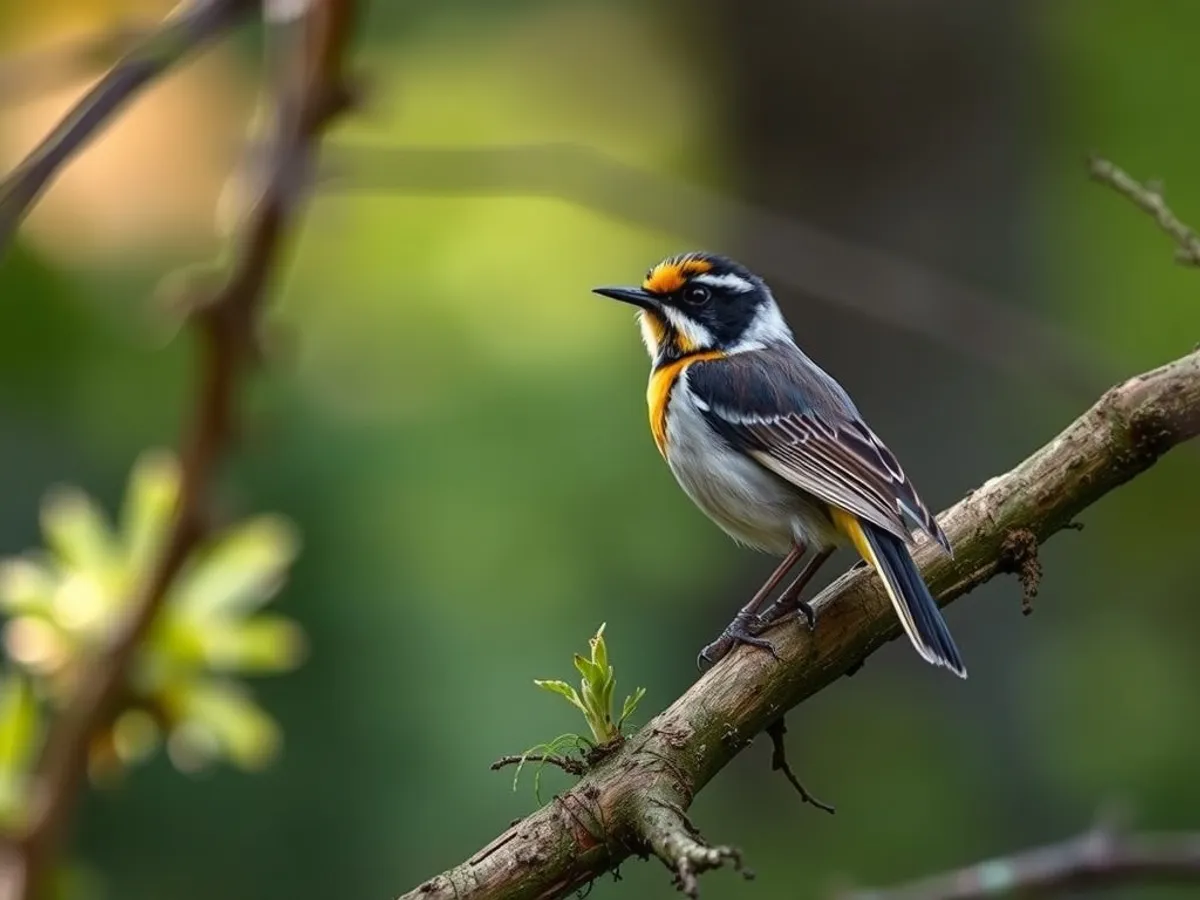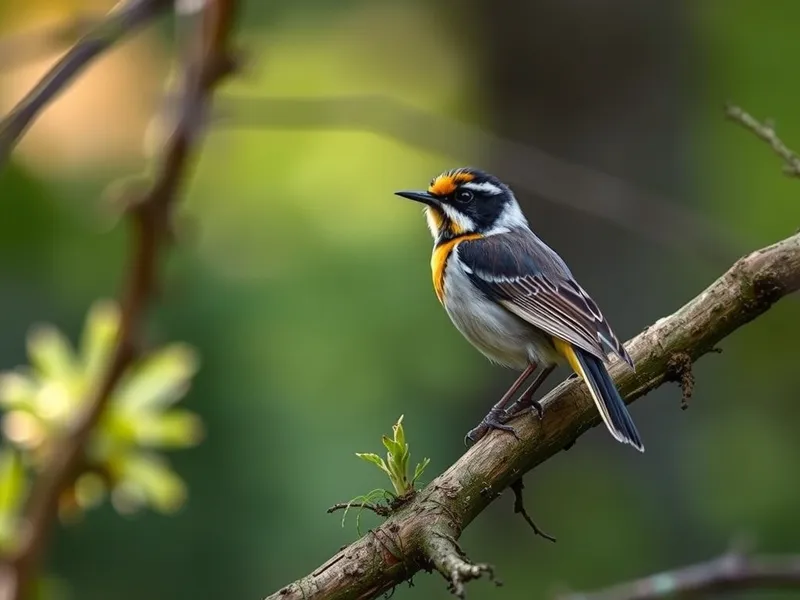
Common Firecrest
Regulus ignicapilla

Meet the Common Firecrest
The Common Firecrest is a tiny, brightly colored songbird native to Europe and parts of North Africa. It is known for its olive-green upperparts, white underparts, distinctive black and white face pattern, and a striking orange or yellow crown stripe bordered by black. The Firecrest is often seen flitting rapidly through coniferous and mixed forests, foraging for small insects and spiders among the foliage. Despite its small size, it is a highly active and agile bird with a sharp, high-pitched song. Its secretive nesting habits and vivid plumage make it a favorite among birdwatchers.
Classification
Bird
Habitat
Coniferous and mixed forests
Diet
Insectivore
Lifespan
2-5 years
Conservation
Least Concern
Weight
4.5–7 grams
📖Fascinating Facts
Forest Dweller
Common Firecrests prefer dense coniferous and mixed forests, especially those with mature spruce or fir trees.
Distinctive Song
This species has a very high-pitched, rapid song that can be difficult for some humans to hear, especially as they age.
Colorful Crown
The bright orange or yellow crown bordered by black is a unique feature, especially pronounced in males during the breeding season.
📋Detailed Description
The Common Firecrest (Regulus ignicapilla) is among the smallest European passerines, measuring just 9–10 cm in length and weighing 4.5–7 grams. Its plumage is striking, with olive-green upperparts, a white belly, and a bold black-and-white facial pattern. The most distinctive feature is the crown stripe: males display a vivid orange crest, while females have a yellow crest, both bordered by black. The bill is fine and pointed, adapted for gleaning tiny arthropods, and the legs are slender, facilitating agile movement among branches. Firecrests are highly active, constantly flicking their wings and tail as they forage. Their large eyes and acute vision aid in detecting prey among dense foliage. The species is generally solitary or found in pairs during the breeding season, but may join mixed-species flocks in winter. Their high-pitched, thin song and sharp calls are characteristic, often the first sign of their presence. Nests are intricately woven, spherical structures suspended from conifer branches, reflecting their secretive and meticulous nesting behavior.
💡 Did you know?
The Common Firecrest is one of the smallest birds in Europe, weighing less than a standard sheet of paper.
🔬Research & Sources
Wikipedia Summary
The common firecrest, also known as the firecrest, is a very small passerine bird in the kinglet family. It breeds in most of temperate Europe and northwestern Africa, and is partially migratory, with birds from central Europe wintering to the south and west of their breeding range. Firecrests in the Balearic Islands and north Africa are widely recognised as a separate subspecies, but the population on Madeira, previously also treated as a subspecies, is now treated as a distinct species, the Madeira firecrest, Regulus madeirensis. A fossil ancestor of the firecrest has been identified from a single wing bone.
Last Modified: 5/4/2025
🎭Behavior & Social Structure
Common Firecrests are diurnal and spend most of their day actively foraging in the upper and middle canopy layers. Their feeding behavior involves rapid, acrobatic movements as they glean insects, spiders, and small arthropods from needles and leaves, often hanging upside down or hovering briefly. They are known for their restless energy, rarely remaining still for more than a few seconds. Socially, firecrests are territorial during the breeding season, with males singing persistently to defend their territory and attract mates. Outside the breeding season, they may join mixed-species flocks, particularly with tits (Paridae) and other small insectivores, which can increase foraging efficiency and reduce predation risk. They exhibit a regular daily routine, with peak activity in the early morning and late afternoon.
👶Reproduction & Life Cycle
The breeding season for Common Firecrests typically spans from April to July, varying with latitude and altitude. Courtship involves males displaying their crest and singing to attract females. Pairs are monogamous for the season. The female constructs a compact, three-layered nest, usually suspended from a conifer branch 2–20 meters above ground. Clutch size ranges from 7 to 12 eggs, which are white with fine reddish speckles. Incubation lasts 14–16 days and is performed solely by the female, while the male provides food. Both parents feed the chicks, which fledge after 16–18 days. Firecrests may raise two broods per season in favorable conditions. Juveniles are independent within a few weeks of fledging.
🛡️Adaptations & Survival
Firecrests possess several adaptations for their arboreal, insectivorous lifestyle. Their small size and low body mass allow for agile maneuvering among dense foliage. The fine, pointed bill is specialized for picking tiny prey from needles and bark crevices. Their cryptic coloration provides camouflage from predators. The bright crown stripe, especially in males, is used in territorial and courtship displays. Physiologically, firecrests have a high metabolic rate to sustain their energetic foraging, and their plumage provides excellent insulation against cold, allowing them to survive harsh winters. Partial migratory behavior in some populations enables them to exploit seasonal food resources and avoid extreme weather.
📚Research Sources
🎨Cultural Significance
In European folklore, the firecrest and its close relative, the goldcrest, have been associated with royalty and the 'king of birds' myth, likely due to their crown-like head markings. The firecrest is admired by birdwatchers for its vivid plumage and energetic behavior, often considered a symbol of vitality and agility. There are no significant traditional uses or economic importance, but the species plays a role in forest ecosystem health as an insect predator.
🔬Recent Research & Discoveries
Recent molecular studies have clarified the taxonomy of the firecrest complex, leading to the recognition of the Madeira Firecrest (Regulus madeirensis) as a distinct species. Genetic analyses support the separation of North African and Balearic populations as subspecies. Fossil evidence, including a Pleistocene wing bone, indicates a long evolutionary history in Europe. Ongoing research focuses on migratory patterns using stable isotope analysis and geolocators, as well as the impacts of climate change on breeding phenology and range shifts. Studies of vocalizations reveal subtle differences between populations, which may contribute to reproductive isolation.
🎥Wildlife Videos

The Secret Lives of Birds and Their Aerial Feats | Full Documentary
We envy birds their mastery of the air, watching them enjoy the freedom of a 3 dimensional space. Flight allows them to get to hard ...
Free High-Quality Documentaries

common firecrest facts
The common firecrest (Regulus ignicapilla), also known as the firecrest, is a very small passerine bird in the kinglet family.
Amazing Planet!

Birds Of US | Most Beautiful Birds In The United States | Wildlife Documentary | BBTV Official
Welcome to BBTV Official, In this celebration of avian splendor, we delve into the lives of the most beautiful birds across the United ...
BBTV Official

The Incredible Scottish Highlands (4K Documentary) | Our World
Narrated by Ewan McGregor, this landmark series gives a beautiful portrait of life in the Scottish Highlands, following the wildlife ...
Our World

Fascinating Birds Of Prey | Wildlife Documentary
Fascinating Birds Of Prey - Birds of prey make some of the most impressive appearances in the sky. Eagles, falcons and hawks ...
Travel Universe

30 Most Beautiful Creatures On Earth (Order Galliformes) | Wildlife Documentary | BBTV Official
In the heart of the world's most remote forests and rugged highlands, where mist lingers over ancient trees and the wilderness ...
BBTV Official
🌍Habitat Information
The Common Firecrest typically inhabits Coniferous and mixed forests environments. Common Firecrests have adapted to their environments with specialized features and behaviors.
Primary Habitat:
Coniferous and mixed forests
More detailed habitat information will be available soon.
🛡️Conservation Status
The Common Firecrest is currently classified as Least Concern. Conservation efforts are crucial for preserving this species for future generations.
Common Threats:
- 🏠Habitat loss and fragmentation
- 🌡️Climate change impacts
- 🎯Hunting and poaching
- 🏭Human-wildlife conflict
⚠️Threats & Conservation Challenges
Currently assessed as Least Concern by the IUCN, the Common Firecrest has a stable and widespread population. However, local declines may occur due to habitat loss from deforestation, changes in forest management, and pesticide use reducing insect prey availability. Climate change poses a potential long-term threat by altering forest composition and phenology. Collisions with man-made structures and predation by domestic cats are minor but persistent threats. Despite these challenges, the species' adaptability to various forest types and its high reproductive output contribute to its resilience.
🔬Scientific Classification
Scientific Name
Regulus ignicapilla
Classification Hierarchy
🔍 About Taxonomic Classification
Taxonomic classification is a hierarchical system used by scientists to classify and organize living organisms based on shared characteristics and evolutionary relationships.
The system moves from broad categories (Kingdom) to increasingly specific ones, with each animal's scientific name typically consisting of its Genus and species.
📝Community Notes
Share your observations and insights about the Common Firecrest with our community of wildlife enthusiasts.
Join Our Community
Sign in to share your observations and connect with fellow wildlife enthusiasts.
Sign In to ContributeNo community notes yet
Be the first to share your observations about the Common Firecrest!
Explore Common Firecrest
Select a tab above to learn more about this amazing animal.
📸Photo Gallery
No photos available for this animal yet.
🌟Discover More Wildlife
Continue your journey of discovery with more fascinating animals from our database
